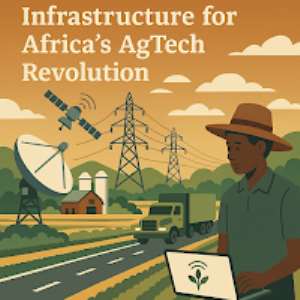 AI generated image
AI generated imageAfrica holds immense potential to become a global agricultural powerhouse, boasting 60% of the world’s uncultivated arable land and a youthful workforce. However, the continent’s agricultural productivity remains hampered by inadequate infrastructure. To harness the benefits of agricultural technology (AgTech), foundational investments in infrastructure are paramount.
Reliable electricity and internet access are foundational to the successful deployment of modern agricultural technologies. These utilities support innovations such as precision farming, which relies on sensors and data analytics to optimize planting and irrigation; mobile-based advisory services that deliver real-time guidance to farmers; and digital marketplaces that connect producers directly with buyers, improving transparency and pricing. Without consistent power and connectivity, these solutions remain out of reach for many rural communities. In Kenya, the Last Mile Connectivity Project has made significant progress in addressing this gap by extending the national electricity grid to rural and peri-urban areas, thereby enabling farmers to operate irrigation systems, use post-harvest storage technologies, and power cold chain logistics, all essential for reducing losses and increasing productivity. Similarly, Rwanda’s partnership with companies like Zipline to operate drone delivery systems exemplifies how improved connectivity can transform agricultural logistics. These drones transport seeds, fertilizers, veterinary supplies, and even medical items to hard-to-reach farming communities in record time, reducing delays that could otherwise compromise production cycles. Together, these examples highlight the critical role of infrastructure in unlocking the full potential of AgTech and driving inclusive agricultural growth.
Efficient transportation networks are vital for reducing post-harvest losses and ensuring that farmers can access markets in a timely and profitable manner. In many rural areas across Africa, poor road conditions, lack of bridges, and seasonal flooding severely limit mobility, making it difficult for farmers to transport their produce before it spoils. Inadequate storage facilities, especially cold storage, further exacerbate food wastage, particularly for perishable crops like fruits and vegetables. Strategic investments in rural road construction, routine maintenance, and the development of cold chain logistics, from refrigerated trucks to community cooling hubs can improve the agricultural value chain by extending shelf life, reducing spoilage, and enabling access to more lucrative markets.
During one of my farm visits, I witnessed firsthand the burden of these infrastructural deficits. A farmer was carrying a large bunch of plantains on his head, walking nearly 8 miles from the mountainous region of Ahankrasu to the nearest market center. After hours of physical exertion under the sun and navigating rough, unpaved paths, he was offered less than $2 for his entire harvest. This nominal payment barely covered the cost of his effort, let alone the value of the produce, and vividly illustrated how infrastructural challenges lead to the undervaluation of farmers’ work. Such conditions not only demoralize producers but also perpetuate cycles of poverty and food insecurity. Closing these infrastructure gaps is not just about roads and storage, it’s about restoring dignity and fairness to those at the foundation of the food supply chain.
Governments play a crucial role in fostering an environment conducive to infrastructure development by setting the regulatory framework, allocating public funds, and coordinating efforts across sectors. Strategic investment in transportation, energy, irrigation, and digital infrastructure is essential for agricultural transformation, especially in rural areas. One effective approach is through Public-Private Partnerships (PPPs), which allow governments to leverage private sector capital, innovation, and efficiency for large-scale projects that might otherwise be unaffordable or difficult to manage alone. For example, Nigeria’s e-wallet fertilizer subsidy program demonstrates how government policy can drive infrastructure utilization through technology. This initiative uses mobile phones to deliver fertilizer vouchers directly to farmers, eliminating middlemen, reducing corruption, and improving timely access to agricultural inputs. Such innovations not only enhance transparency and efficiency but also create digital infrastructure that can be scaled to support broader rural development goals, such as market access, extension services, and financial inclusion.
Strengthening infrastructure is the cornerstone of Africa’s AgTech transformation and a prerequisite for sustainable agricultural development. Without reliable infrastructure, spanning electricity, digital connectivity, transportation, and enabling policy environments, efforts to modernize agriculture will remain fragmented and inaccessible to many rural communities. Electrification empowers farmers to adopt technologies like irrigation systems, cold storage, and agro-processing equipment that can reduce losses and increase productivity. Expanding internet connectivity allows for the integration of precision agriculture tools, mobile advisory platforms, and digital marketplaces that bridge information and market gaps.
Improved transportation infrastructure, including all-weather rural roads and efficient logistics systems, is critical for minimizing post-harvest losses and ensuring that produce reaches markets promptly and in good condition. Equally important are supportive policies and public-private partnerships that create the conditions for scalable innovation and investment. By aligning infrastructure development with agricultural priorities, African countries can unlock the full potential of AgTech to boost productivity, increase incomes, and achieve food security. This comprehensive approach not only addresses the immediate needs of smallholder farmers but also positions agriculture as a powerful engine for inclusive economic growth, job creation, and resilience in the face of climate and market shocks.
Akwasi Tagoe.
“the best culture is agriculture”


